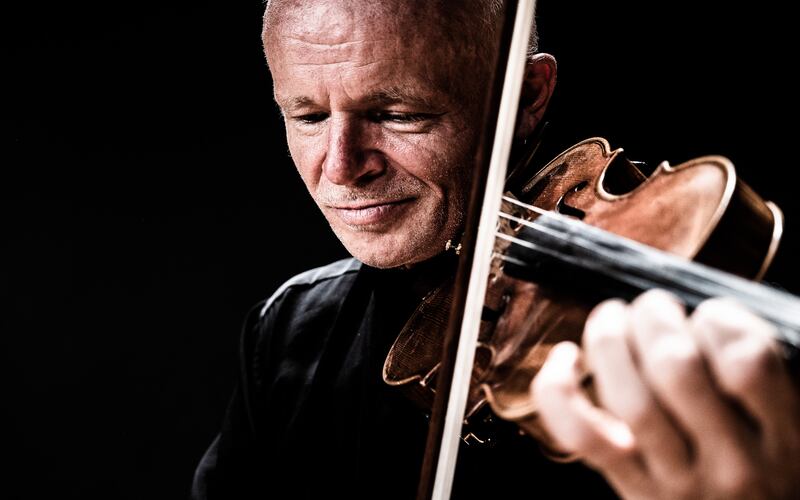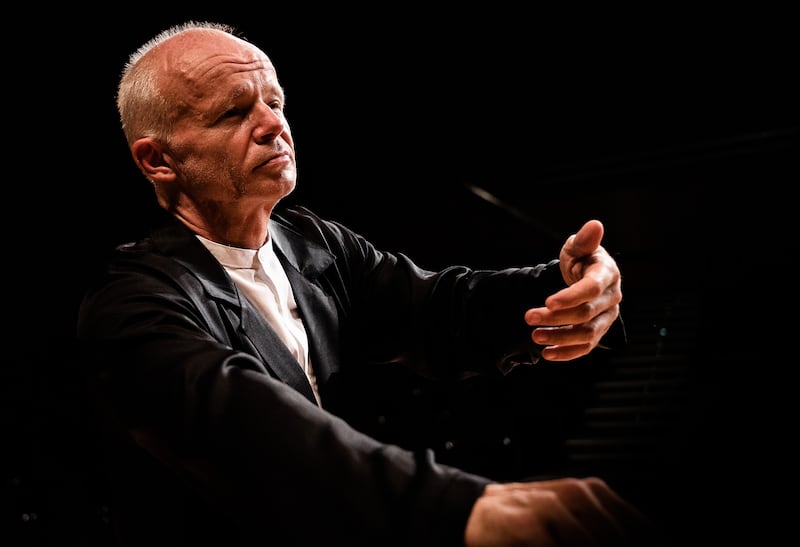Austrian conductor and violinist Thomas Zehetmair, recently appointed principal conductor and artistic partner of the Irish Chamber Orchestra (ICO), is about to make his formal debut in his new role in Dublin and Limerick. He conducts two of Mozart’s greatest symphonies, No 38 (the Prague) and No 40 in G minor, and is also the soloist in German composer Karl Amadeus Hartmann’s 1939 Concerto funèbre.
Zehetmair is one of those musicians who seems to have been destined for the violin. His parents were both violinists, members of the Camerata Salzburg in the 1950s. His father, Helmut, was a notable music pedagogue, whose pupils included members of the great Hagen Quartet and a string of orchestra leaders. “In a way he got a reputation from me,” says the son. “But I got a fantastic schooling from him. I was very well trained by him.”
He doesn’t make the point himself but his father had an impressive musical lineage. He studied with Franz Samohyl who, in turn, had studied with Arnold Rosé, leader of the Vienna Philharmonic Orchestra, brother-in-law of Mahler and founder of the Rosé String Quartet, which gave first the performances of works by Brahms, Korngold, Schoenberg and Webern. Later teachers included Max Rostal, who studied with Carl Flesch, one of the most influential of violin teachers, and Nathan Milstein, who was taught by the even more influential Leopold Auer, teacher of many of the greatest violinists of the 20th century.
Zehetmair’s first instrument, however, was the piano, from the age of three. He took up the violin from the age of seven. The piano couldn’t give him the control he wanted. It has no way of making a crescendo on an individual note, and the nuancing offered by vibrato on the violin was a huge draw. “There are,” he says, “a hundred thousand possibilities of making different vibratos.”
The Enlightenment gave rise to a habit of worshipping ‘great men’, but they never had to worry about dying in childbirth
Neutrality fight beckons over proposal to modify ‘triple lock’ on overseas troop deployments
‘Where I come from, people don’t do medicine. It’s not on your radar’: how a new generation of GPs is being trained
Dancing with the Stars: ‘I’ve had the best time of my life. I feel super fit,’ chef Kevin Dundon says as he is voted off show

There was a time in the 20th century when the use of continuous vibrato became something of a cliche, a quick route to the suggestion of romanticism. A key influence that turned Zehetmair in a different direction was the period instruments pioneer Nikolaus Harnoncourt.
“He held lectures when I was still a student in Salzburg,” he explains. “I played for him and he asked me to be concertmaster in his ensemble, Concentus Musicus. So, very early in my life, I played the baroque violin and learned a lot about baroque phrasing, and the use of vibrato as well. And, more than anything else from Nikolaus Harnoncourt, the idea that music has to do with life, with emotions of life, with what you express in life. What you speak in life is a musical mirror or projection or big expression of that.” Among later conducting influences he names Frans Brüggen, founder of the Orchestra of the 18th Century (“my favourite to work with,” and with whom he recorded concertos by Mozart and Beethoven), and also David Zinman and Michael Gielen, “who also taught me conducting”.
He doesn’t agree with the notion that conductors, who perform without being heard, can, unlike instrumentalists and singers, get away without real technique.
“If you achieve fantastic music with your appearance or your emotions, then you cannot call this bad conducting technique. Conducting technique is something very individual. There are also many different schools.”
For conductors he says: “the main thing is the music you want to achieve, and how you express it [to players] is secondary. If you express it, and you reach what you want, and what you want to hear, then certainly this is more successful than when you have good mechanics but nothing behind it.”
“Conducting,” he continues, “is the visual showing of something which you are supposed to hear. You stand in front of an orchestra and you project your music. The second level is to rehearse, to talk to people, to appreciate what you hear, to co-ordinate what you hear. Sometimes you hear something and it exceeds your boldest expectation and is so beautiful you are inspired by the orchestra. To put that all together in a certain way, that’s also a very big art. You have to gain the most energy from the potential of the players. And of course you have to have an exact idea of what you want to say through music. You have to have that as a conductor. As you said, you don’t hear anything from the movements.”

In the 1990s Zehetmair became famous for founding and leading a string quartet that played concerts from memory. From a young age he had participated in major chamber music festivals, including those at Lockenhaus and Kuhmo. “I was eager to eat all the chamber music pieces for myself,” he says, “to read them, to play and perform. You meet with colleagues, you play, you get very inspired, there’s a lot of talk.”
Although he says “maybe the performances were more spontaneous than deep”, he still describes it as “a fantastic experience”. But he knew he wanted something different, he wanted to immerse himself in the world of the string quartet. “The best composers of all periods surpassed themselves when writing string quartets. They were really at their peak.” And he felt that working on quartets could be improved upon if everyone came to rehearsals already knowing the works by heart.
That meant “we could start on a much, much higher level when rehearsing it. So we did. All four of us liked it. By putting the music stands aside, we had much more eye contact. We could sit closer. We could do many more spontaneous impulses in the music. That was a fantastic concept for us. But we forbade the organisers of the concerts to mention that we played by heart. Because each of us had the right to say: ‘let’s play with music tonight because I don’t feel so well, or whatever.’” Which, he says, only happened once or twice. And now, he says, they can “feel” their routine of playing the music by heart, while still having the music on the stand.
He’s “thrilled” at his new relationship with the ICO. He describes the players as “great”, praising their “enormous energy and enormous enthusiasm”. His initial focus has been on Mozart and Haydn. He describes the Hartmann Concerto funèbre as “a very emotional statement against the war, against the Nazi regime. Hartmann wrote a piece, Miserae [1933-34, his first orchestral work], and dedicated it to his murdered friends in Dachau. This was not of course performed in Germany at that time.”
The Concerto funèbre was written just at the beginning of the second World War. “It’s a big outcry, one of the most expressive concertos of the 20th century. And also, for violinists, it is one of the most important violin concertos of the 20th century.” Hans Werner Henze called Hartmann “the younger but important brother of Mahler and Bruckner,” although that doesn’t quite convey how fully of its time Hartmann’s music actually sounds.
Zehetmair has what comes across as a hell-or-high-water ambition to programme Hartmann’s Fourth Symphony of 1947, “which is for strings only, and which is an equally deep piece as the Concerto funèbre”.
After the second World War Hartmann founded the Musica Viva festival in Munich, and Zehetmair admires him for the fact that “he featured all his colleagues and he never made a fuss of his own compositions. He didn’t really advertise his music, in the way composers today are obliged to be heard. Of course, he was regarded very highly. It was probably just his philosophy. That might also be the reason why he has remained less well known.”

He’s clearly proud of the fact that when Schott Music, publisher of Hartmann’s music, discovered two manuscripts of unperformed solo violin sonatas, he was the player they approached to give the first performances. “They were written for a fellow-student. Schott gave them to me and I premiered them at the Music Viva series in Munich.”
Zehetmair’s relationship with contemporary Irish music is long-standing. He has performed works by Gerald Barry – Feldman’s Sixpenny Editions and Wiener Blut – and Raymond Deane’s Embers is already in the works. “We will,” he says, “discover other Irish pieces and put them into programmes with classic composers and other modern composers”.
He talks with some anguish about how “this big Covid break was really a catastrophe for every musician” and with relief about the fact that “we are back to playing for live audiences”.
But he understands “that the full audience is not yet back. But we want to work very much on that. To play in front of audiences and to show that we do great music and popular music. Most of the popular pieces are among the greatest pieces ever written, like the G minor Symphony by Mozart, which we’re doing in our next programme. We will show that great music is popular, and also there is a lot of great music which people will be curious to hear for the first time.”
Thomas Zehetmair performs Mozart and Hartmann with the Irish Chamber Orchestra at the National Concert Hall on Wednesday, November 30th, and at University Concert Hall, Limerick, on Thursday, December 1st. irishchamberorchestra.com















